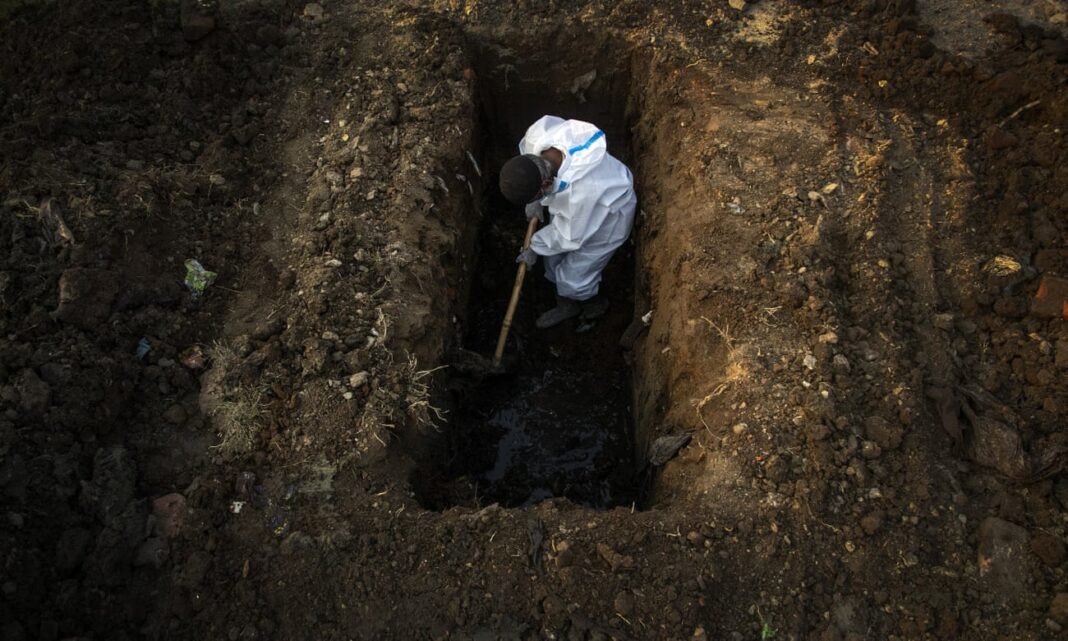It’s hard to convey the full depth and range of the trauma, the chaos and the indignity that people are being subjected to. Meanwhile, Modi and his allies are telling us not to complain.
uring a particularly polarising election campaign in the state of Uttar Pradesh in 2017, India’s prime minister, Narendra Modi, waded into the fray to stir things up even further. From a public podium, he accused the state government – which was led by an opposition party – of pandering to the Muslim community by spending more on Muslim graveyards (kabristans) than on Hindu cremation grounds (shamshans). With his customary braying sneer, in which every taunt and barb rises to a high note mid-sentence before it falls away in a menacing echo, he stirred up the crowd. “If a kabristan is built in a village, a shamshan should also be constructed there,” he said.
“Shamshan! Shamshan!” the mesmerised, adoring crowd echoed back.
Perhaps he is happy now that the haunting image of the flames rising from the mass funerals in India’s cremation grounds is making the front page of international newspapers. And that all the kabristans and shamshans in his country are working properly, in direct proportion to the populations they cater for, and far beyond their capacities.
“Can India, population 1.3 billion, be isolated?” the Washington Post asked rhetorically in a recent editorial about India’s unfolding catastrophe and the difficulty of containing new, fast-spreading Covid variants within national borders. “Not easily,” it replied. It’s unlikely this question was posed in quite the same way when the coronavirus was raging through the UK and Europe just a few months ago. But we in India have little right to take offence, given our prime minister’s words at the World Economic Forum in January this year.
Modi spoke at a time when people in Europe and the US were suffering through the peak of the second wave of the pandemic. He had not one word of sympathy to offer, only a long, gloating boast about India’s infrastructure and Covid-preparedness. I downloaded the speech because I fear that when history is rewritten by the Modi regime, as it soon will be, it might disappear, or become hard to find. Here are some priceless snippets:
“Friends, it would not be advisable to judge India’s success with that of another country. In a country which is home to 18% of the world population, that country has saved humanity from a big disaster by containing corona effectively.”
Modi the magician takes a bow for saving humanity by containing the coronavirus effectively. Now that it turns out that he has not contained it, can we complain about being viewed as though we are radioactive? That other countries’ borders are being closed to us and flights are being cancelled? That we’re being sealed in with our virus and our prime minister, along with all the sickness, the anti-science, the hatred and the idiocy that he, his party and its brand of politics represent?
When the first wave of Covid came to India and then subsided last year, the government and its supportive commentariat were triumphant. “India isn’t having a picnic,” tweeted Shekhar Gupta, the editor-in-chief of the online news site the Print. “But our drains aren’t choked with bodies, hospitals aren’t out of beds, nor crematoriums & graveyards out of wood or space. Too good to be true? Bring data if you disagree. Unless you think you’re god.” Leave aside the callous, disrespectful imagery – did we need a god to tell us that most pandemics have a second wave?
Oxygen is the new currency on India’s morbid new stock exchange. Senior politicians, journalists, lawyers – India’s elite – are on Twitter pleading for hospital beds and oxygen cylinders. The hidden market for cylinders is booming. Oxygen saturation machines and drugs are hard to come by.
There are markets for other things, too. At the bottom end of the free market, a bribe to sneak a last look at your loved one, bagged and stacked in a hospital mortuary. A surcharge for a priest who agrees to say the final prayers. Online medical consultancies in which desperate families are fleeced by ruthless doctors. At the top end, you might need to sell your land and home and use up every last rupee for treatment at a private hospital. Just the deposit alone, before they even agree to admit you, could set your family back a couple of generations.
None of this conveys the full depth and range of the trauma, the chaos and, above all, the indignity that people are being subjected to. What happened to my young friend T is just one of hundreds, perhaps thousands of similar stories in Delhi alone. T, who is in his 20s, lives in his parents’ tiny flat in Ghaziabad on the outskirts of Delhi. All three of them tested positive for Covid. His mother was critically ill. Since it was in the early days, he was lucky enough to find a hospital bed for her. His father, diagnosed with severe bipolar depression, turned violent and began to harm himself. He stopped sleeping. He soiled himself. His psychiatrist was online trying to help, although she also broke down from time to time because her husband had just died from Covid. She said T’s father needed hospitalisation, but since he was Covid positive there was no chance of that. So T stayed awake, night after night, holding his father down, sponging him, cleaning him up. Each time I spoke to him I felt my own breath falter. Finally, the message came: “Father’s dead.” He did not die of Covid, but of a massive spike in blood pressure induced by a psychiatric meltdown induced by utter helplessness.
T’s father was cremated. T and his mother are recovering.
Things will settle down eventually. Of course, they will. But we don’t know who among us will survive to see that day. The rich will breathe easier. The poor will not. For now, among the sick and dying, there is a vestige of democracy. The rich have been felled, too. Hospitals are begging for oxygen. Some have started bring-your-own-oxygen schemes. The oxygen crisis has led to intense, unseemly battles between states, with political parties trying to deflect blame from themselves.
On the night of 22 April, 25 critically ill coronavirus patients on high-flow oxygen died in one of Delhi’s biggest private hospitals, Sir Ganga Ram. The hospital issued several desperate SOS messages for the replenishment of its oxygen supply. A day later, the chair of the hospital board rushed to clarify matters: “We cannot say that they have died due to lack of oxygen support.” On 24 April, 20 more patients died when oxygen supplies were depleted in another big Delhi hospital, Jaipur Golden. That same day, in the Delhi high court, Tushar Mehta, India’s solicitor general, speaking for the government of India, said: “Let’s try and not be a cry baby … so far we have ensured that no one in the country was left without oxygen.”
Ajay Mohan Bisht, the saffron-robed chief minister of Uttar Pradesh, who goes by the name Yogi Adityanath, has declared that there is no shortage of oxygen in any hospital in his state and that rumourmongers will be arrested without bail under the National Security Act and have their property seized.
Yogi Adityanath doesn’t play around. Siddique Kappan, a Muslim journalist from Kerala, jailed for months in Uttar Pradesh when he and two others travelled there to report on the gang-rape and murder of a Dalit girl in Hathras district, is critically ill and has tested positive for Covid. His wife, in a desperate petition to the chief justice of the supreme court of India, says her husband is lying chained “like an animal” to a hospital bed in the Medical College hospital in Mathura. (The supreme court has now ordered the Uttar Pradesh government to move him to a hospital in Delhi.) So, if you live in Uttar Pradesh, the message seems to be, please do yourself a favour and die without complaining.
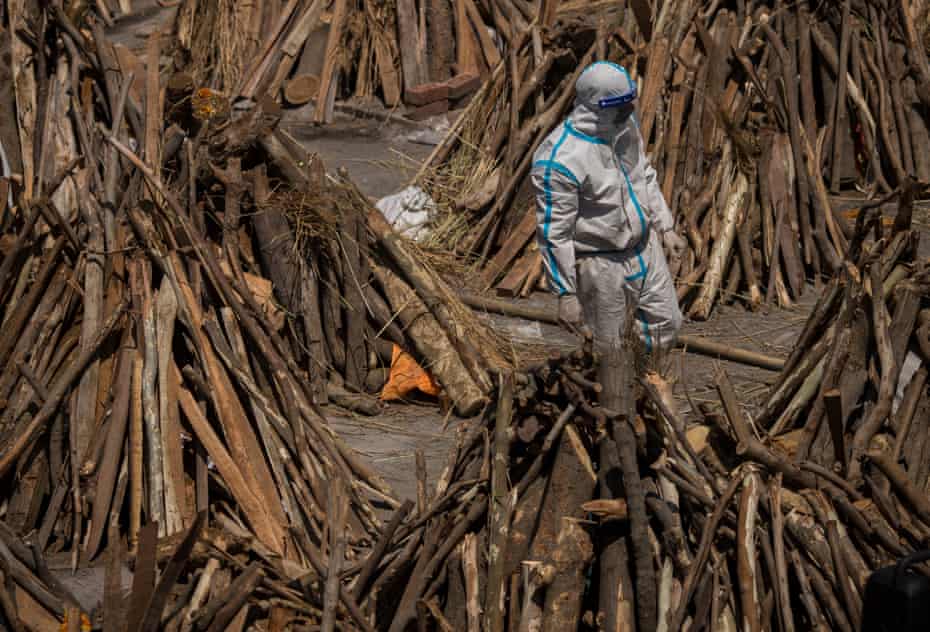
Where shall we look for solace? For science? Shall we cling to numbers? How many dead? How many recovered? How many infected? When will the peak come? On 27 April, the report was 323,144 new cases, 2,771 deaths. The precision is somewhat reassuring. Except – how do we know? Tests are hard to come by, even in Delhi. The number of Covid-protocol funerals from graveyards and crematoriums in small towns and cities suggest a death toll up to 30 times higher than the official count. Doctors who are working outside the metropolitan areas can tell you how it is.
If Delhi is breaking down, what should we imagine is happening in villages in Bihar, in Uttar Pradesh, in Madhya Pradesh? Where tens of millions of workers from the cities, carrying the virus with them, are fleeing home to their families, traumatised by their memory of Modi’s national lockdown in 2020. It was the strictest lockdown in the world, announced with only four hours’ notice. It left migrant workers stranded in cities with no work, no money to pay their rent, no food and no transport. Many had to walk hundreds of miles to their homes in far-flung villages. Hundreds died on the way.
This time around, although there is no national lockdown, the workers have left while transport is still available, while trains and buses are still running. They’ve left because they know that even though they make up the engine of the economy in this huge country, when a crisis comes, in the eyes of this administration, they simply don’t exist. This year’s exodus has resulted in a different kind of chaos: there are no quarantine centres for them to stay in before they enter their village homes. There’s not even the meagre pretence of trying to protect the countryside from the city virus.
These are villages where people die of easily treatable diseases like diarrhoea and tuberculosis. How are they to cope with Covid? Are Covid tests available to them? Are there hospitals? Is there oxygen? More than that, is there love? Forget love, is there even concern? There isn’t. Because there is only a heart-shaped hole filled with cold indifference where India’s public heart should be.
Early this morning, on 28 April, news came that our friend Prabhubhai has died. Before he died, he showed classic Covid symptoms. But his death will not register in the official Covid count because he died at home without a test or treatment. Prabhubhai was a stalwart of the anti-dam movement in the Narmada valley. I stayed several times at his home in Kevadia, where decades ago the first group of indigenous tribespeople were thrown off their lands to make room for the dam-builders and officers’ colony. Displaced families like Prabhubhai’s still remain on the edges of that colony, impoverished and unsettled, transgressors on land that was once theirs.
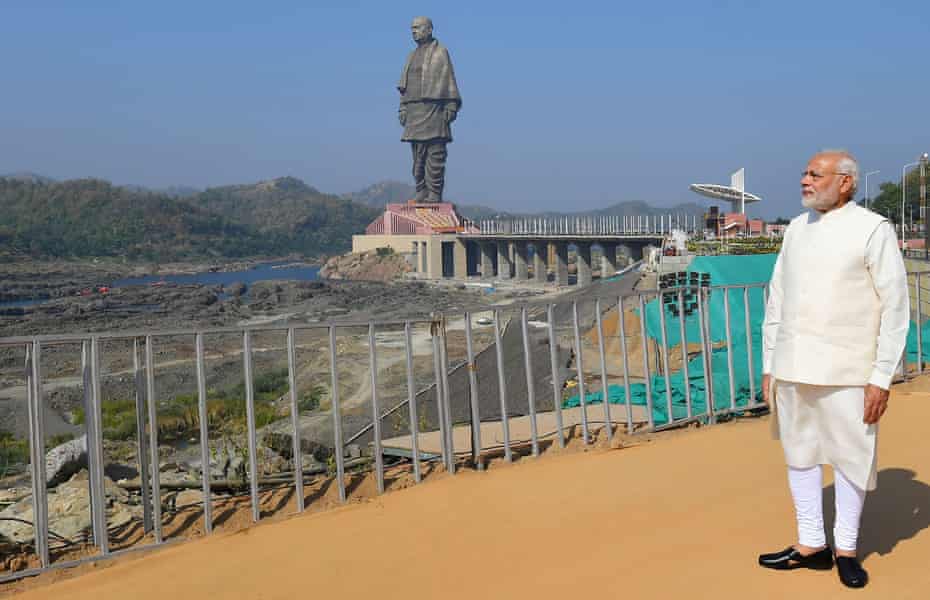
The friend who messaged about Prabhubhai had spent years as an anti-dam activist in the Narmada valley. She wrote: “My hands shiver as I write this. Covid situation in and around Kevadia Colony grim.”
The precise numbers that make up India’s Covid graph are like the wall that was built in Ahmedabad to hide the slums Donald Trump would drive past on his way to the “Namaste Trump” event that Modi hosted for him in February 2020. Grim as those numbers are, they give you a picture of the India-that-matters, but certainly not the India that is. In the India that is, people are expected to vote as Hindus, but die as disposables.
“Let’s try and not be a cry baby.”
Understand that there were and are so many far more pressing issues for the Modi government to attend to. Destroying the last vestiges of democracy, persecuting non-Hindu minorities and consolidating the foundations of the Hindu Nation makes for a relentless schedule. There are massive prison complexes, for example, that must be urgently constructed in Assam for the 2 million people who have lived there for generations and have suddenly been stripped of their citizenship. (On this matter, our independent supreme court came down hard on the side of the government.)
There are hundreds of students and activists and young Muslim citizens to be tried and imprisoned as the primary accused in the anti-Muslim pogrom that took place against their own community in north-east Delhi last March. If you are Muslim in India, it’s a crime to be murdered. Your folks will pay for it. There was the inauguration of the new Ram Temple in Ayodhya, which is being built in place of the mosque that was hammered to dust by Hindu vandals watched over by senior BJP politicians. (On this matter, our independent supreme court came down hard on the side of the government and leniently on the side of the vandals.) There were the controversial new Farm Bills to be passed, corporatising agriculture. There were hundreds of thousands of farmers to be beaten and teargassed when they came out on to the streets to protest.
Then there’s the multi-multi-multimillion-dollar plan for a grand new replacement for the fading grandeur of New Delhi’s imperial centre to be urgently attended to. After all, how can the government of the new Hindu India be housed in old buildings? While Delhi is locked down, ravaged by the pandemic, construction work on the “Central Vista” project, declared as an essential service, has begun. Workers are being transported in. Maybe they can alter the plans to add a crematorium.
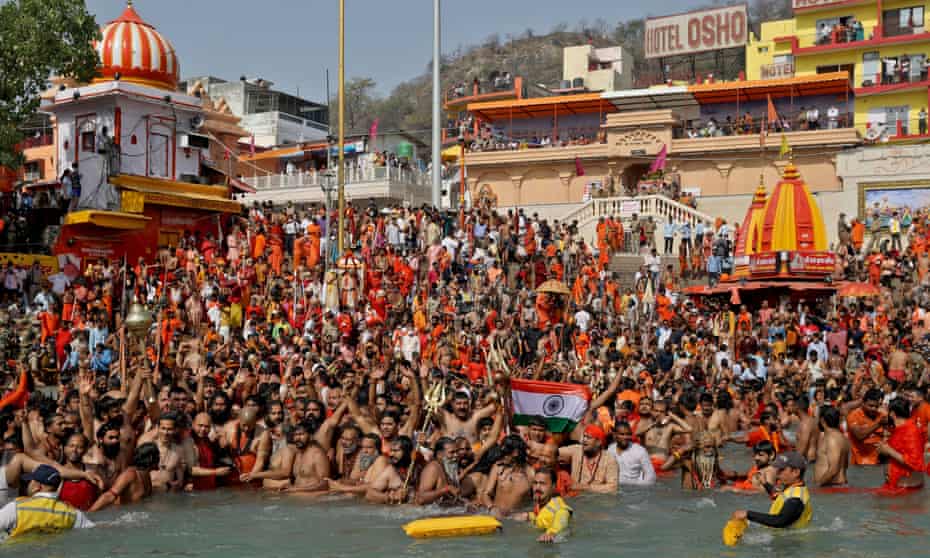
So, as you can tell, it’s been busy, busy, busy.
Over and above all this urgent activity, there is an election to be won in the state of West Bengal. This required our home minister, Modi’s man Amit Shah, to more or less abandon his cabinet duties and focus all his attention on Bengal for months, to disseminate his party’s murderous propaganda, to pit human against human in every little town and village. Geographically, West Bengal is a small state. The election could have taken place in a single day, and has done so in the past. But since it is new territory for the BJP, the party needed time to move its cadres, many of who are not from Bengal, from constituency to constituency to oversee the voting. The election schedule was divided into eight phases, spread out over a month, the last on 29 April. As the count of corona infections ticked up, the other political parties pleaded with the election commission to rethink the election schedule. The commission refused and came down hard on the side of the BJP, and the campaign continued. Who hasn’t seen the videos of the BJP’s star campaigner, the prime minister himself, triumphant and maskless, speaking to the maskless crowds, thanking people for coming out in unprecedented numbers? That was on 17 April, when the official number of daily infections was already rocketing upward of 200,000.
Now, as voting closes, Bengal is poised to become the new corona cauldron, with a new triple mutant strain known as – guess what – the “Bengal strain”. Newspapers report that every second person tested in the state capital, Kolkata, is Covid positive. The BJP has declared that if it wins Bengal, it will ensure people get free vaccines. And if it doesn’t?
“Let’s try and not be a cry baby.”
Anyway, what about the vaccines? Surely they’ll save us? Isn’t India a vaccine powerhouse? In fact, the Indian government is entirely dependent on two manufacturers, the Serum Institute of India (SII) and Bharat Biotech. Both are being allowed to roll out two of the most expensive vaccines in the world, to the poorest people in the world. This week they announced that they will sell to private hospitals at a slightly elevated price, and to state governments at a somewhat lower price. Back-of-the-envelope calculations show the vaccine companies are likely to make obscene profits.
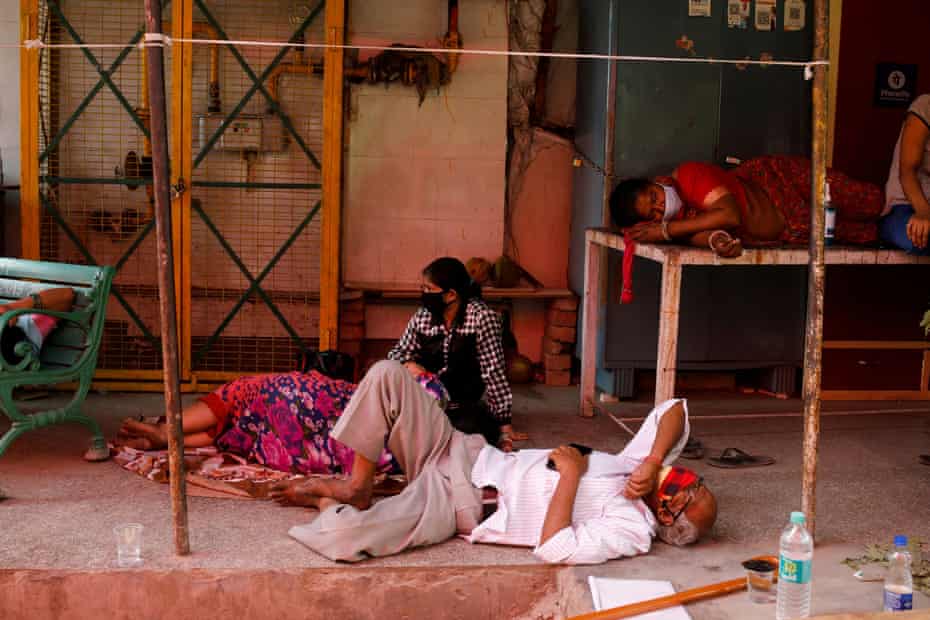
As this epic catastrophe plays out on our Modi-aligned Indian television channels, you’ll notice how they all speak in one tutored voice. The “system” has collapsed, they say, again and again. The virus has overwhelmed India’s health care “system”.
The system has not collapsed. The “system” barely existed. The government – this one, as well as the Congress government that preceded it – deliberately dismantled what little medical infrastructure there was. This is what happens when a pandemic hits a country with an almost nonexistent public healthcare system. India spends about 1.25% of its gross domestic product on health, far lower than most countries in the world, even the poorest ones. Even that figure is thought to be inflated, because things that are important but do not strictly qualify as healthcare have been slipped into it. So the real figure is estimated to be more like 0.34%. The tragedy is that in this devastatingly poor country, as a 2016 Lancet study shows, 78% of the healthcare in urban areas and 71% in rural areas is now handled by the private sector. The resources that remain in the public sector are systematically siphoned into the private sector by a nexus of corrupt administrators and medical practitioners, corrupt referrals and insurance rackets.
The system hasn’t collapsed. The government has failed. Perhaps “failed” is an inaccurate word, because what we are witnessing is not criminal negligence, but an outright crime against humanity. Virologists predict that the number of cases in India will grow exponentially to more than 500,000 a day. They predict the death of many hundreds of thousands in the coming months, perhaps more. My friends and I have agreed to call each other every day just to mark ourselves present, like roll call in our school classrooms. We speak to those we love in tears, and with trepidation, not knowing if we will ever see each other again. We write, we work, not knowing if we will live to finish what we started. Not knowing what horror and humiliation awaits us. The indignity of it all. That is what breaks us.
The hashtag #ModiMustResign is trending on social media. Some of the memes and illustrations show Modi with a heap of skulls peeping out from behind the curtain of his beard. Modi the Messiah speaking at a public rally of corpses. Modi and Amit Shah as vultures, scanning the horizon for corpses to harvest votes from. But that is only one part of the story. The other part is that the man with no feelings, the man with empty eyes and a mirthless smile, can, like so many tyrants in the past, arouse passionate feelings in others. His pathology is infectious. And that is what sets him apart. In north India, which is home to his largest voting base, and which, by dint of sheer numbers, tends to decide the political fate of the country, the pain he inflicts seems to turn into a peculiar pleasure.
Fredrick Douglass said it right: “The limits of tyrants are prescribed by the endurance of those whom they oppress.” How we in India pride ourselves on our capacity to endure. How beautifully we have trained ourselves to meditate, to turn inward, to exorcise our fury as well as justify our inability to be egalitarian. How meekly we embrace our humiliation.
When he made his political debut as Gujarat’s new chief minister in 2001, Modi ensured his place in posterity after what has come to be known as the 2002 Gujarat pogrom. Over a period of a few days, Hindu vigilante mobs, watched over and sometimes actively assisted by the Gujarat police, murdered, raped and burned alive thousands of Muslims as “revenge” for a gruesome arson attack on a train in which more than 50 Hindu pilgrims had been burned alive. Once the violence subsided, Modi, who had until then only been appointed as chief minister by his party, called for early elections. The campaign in which he was portrayed as Hindu Hriday Samrat (“The Emperor of Hindu Hearts”) won him a landslide victory. Modi hasn’t lost an election since.
Several of the killers in the Gujarat pogrom were subsequently captured on camera by the journalist Ashish Khetan, boasting of how they hacked people to death, slashed pregnant women’s stomachs open and smashed infants’ heads against rocks. They said they could only have done what they did because Modi was their chief minister. Those tapes were broadcast on national TV. While Modi remained in the seat of power, Khetan, whose tapes were submitted to the courts and forensically examined, appeared as a witness on several occasions. Over time, some of the killers were arrested and imprisoned, but many were let off. In his recent book, Undercover: My Journey Into the Darkness of Hindutva, Khetan describes in detail how, during Modi’s tenure as chief minister, the Gujarat police, judges, lawyers, prosecutors and inquiry committees all colluded to tamper with evidence, intimidate witnesses and transfer judges.
Despite knowing all this, many of India’s so-called public intellectuals, the CEOs of its major corporations and the media houses they own, worked hard to pave the way for Modi to become the prime minister. They humiliated and shouted down those of us who persisted in our criticism. “Move on”, was their mantra. Even today, they mitigate their harsh words for Modi with praise for his oratory skills and his “hard work”. Their denunciation and bullying contempt for politicians in opposition parties is far more strident. They reserve their special scorn for Rahul Gandhi of the Congress party, the only politician who has consistently warned of the coming Covid crisis and repeatedly asked the government to prepare itself as best it could. To assist the ruling party in its campaign to destroy all opposition parties amounts to colluding with the destruction of democracy.
So here we are now, in the hell of their collective making, with every independent institution essential to the functioning of a democracy compromised and hollowed out, and a virus that is out of control.
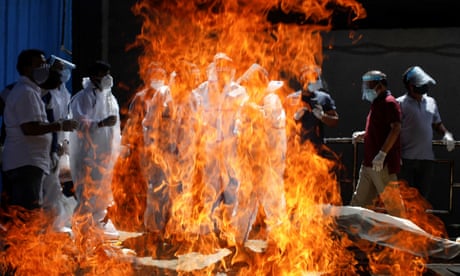
The crisis-generating machine that we call our government is incapable of leading us out of this disaster. Not least because one man makes all the decisions in this government, and that man is dangerous – and not very bright. This virus is an international problem. To deal with it, decision-making, at least on the control and administration of the pandemic, will need to pass into the hands of some sort of non-partisan body consisting of members of the ruling party, members of the opposition, and health and public policy experts.
As for Modi, is resigning from your crimes a feasible proposition? Perhaps he could just take a break from them – a break from all his hard work. There’s that $564m Boeing 777, Air India One, customised for VVIP travel – for him, actually – that’s been sitting idle on the runway for a while now. He and his men could just leave. The rest of us will do all we can to clean up their mess.
No, India cannot be isolated. We need help.
